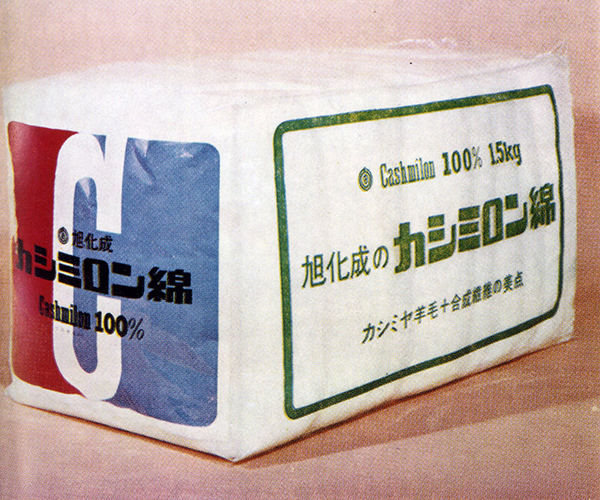After the rayon slump, Asahi Kasei looked for opportunities to move into the field of synthetic fibers. Toyo Rayon Co., Ltd. (now Toray Industries, Inc.) had already commercialized nylon in autumn 1952, and both they and Teijin were importing polyester technology from the UK. The trend of the fiber industry was shifting from natural and regenerated fibers to synthetic fibers.
Since Asahi Kasei was late to synthetics, we had to hurry. The question was which fiber we should get into. Nylon was exhibiting explosive growth at the time, so the common-sense approach would have been to go for nylon. But Asahi Kasei expanded to acrylic fiber. This was because we had been researching acrylic fiber since before the war, and by 1955 we were getting close to commercializing it. We built a one-ton per day pilot plant in Nobeoka in July 1957.
Around that time, Toyobo Co., Ltd. and MITSUBISHI RAYON CO., LTD. were also importing technology from overseas and working on commercializing acrylic fiber. There was no time to waste. Having been promoted to Senior Managing Director in April 1958, I discussed it with the President and started looking for a factory site. We obtained a plot of approximately 760,000 m2 in Fuji City, Shizuoka, in July 1958.
We quickly started phase one of the construction, and in May 1959 completed a 10-ton per day plant at a cost of 5.6 billion yen.
That was the birth of Cashmilon™ acrylic fiber. We ran a TV commercial with the jingle “Nice touch, cashmere touch, that’s the touch” at the start of a popular talk show which was aired all over Japan.
In contrast to the commercial’s lighthearted melody, Cashmilon encountered unexpected struggles. This was because we kept changing the product due to repeated quality improvements, which confused the users.
The main raw material of Cashmilon was acrylonitrile monomer, and the product is made by polymerizing it. Since we hadn’t standardized the manufacturing process, just a small change in the process would cause the plant to be filled with lint swirling around. The dyeing also looked completely different from day to day.
Sales failed to pick up, and unsold stocks piled up. Nonviable inventories reached 6.5 billion yen, exceeding our capital stock of 4.76 billion yen. Since we quickly built a large plant in Fuji, interest payments and depreciation weighed heavily. Our financial performance nosedived, hitting rock bottom in the six-month period to March 1961 with net income of 310 million yen, only one-third of the preceding period.
 The author inspecting the Fuji plant
The author inspecting the Fuji plant
We had to reduce dividends from 12% to 4%, and issued 80% new shares gratis to existing shareholders at the same time. Toray had net income of more than 5 billion yen for the same period, leaving us way behind.
Under these circumstances, President Takenobu Kataoka fell ill due to mental stress and became unable to execute his duties. I was chosen to replace him, and became President in July 1961 at the age of 52.
I immediately took 20% of the administrative staff and put them in Cashmilon sales to strengthen the business. Then I solicited 1,000 voluntary resignations from among housewives whose husbands also worked. They let the company defer their severance payments, saying that we could pay after performance had recovered. This very much helped us to conserve funds. I thought this would allow the company to recover. I will never forget the goodwill they showed. We even paid part of the bonuses in the form of Cashmilon blankets and Asahi-Aji seasoning.
Next, I appointed Koichi Kosho (who later became Director) as the chief of the Cashmilon Sales Department. When Bemberg was slumping due to lack of differentiation from viscose rayon, he got the business back on track by coming up with various new ideas, including the “chop system” of having the company handle marketing, and the hired weaving and processing system where the fabric-making is commissioned but not the sales.
With Mr. Kosho in charge of marketing, the target for Cashmilon was switched from woven textiles to knitted textiles, and we developed our own knitting business. This allowed us to open new markets for Cashmilon. We also focused the technicians on stable quality, and instituted the “80% rule.”
Thanks to the effort of Mr. Kosho and others, we enjoyed a boom in knit-related demand, and Cashmilon grew to be a mainstay of Asahi Kasei. The Italian company ANIC S.P.A. requested a technology transfer, reflecting the excellent reputation that Cashmilon had earned not only in Japan but also around the world.
Sadly Mr. Kosho, who contributed so much to the business, passed away at the age of 47 in June 1964. This was a truly great loss.
 Cashmilon™ for acrylic bedclothes cotton
Cashmilon™ for acrylic bedclothes cotton

